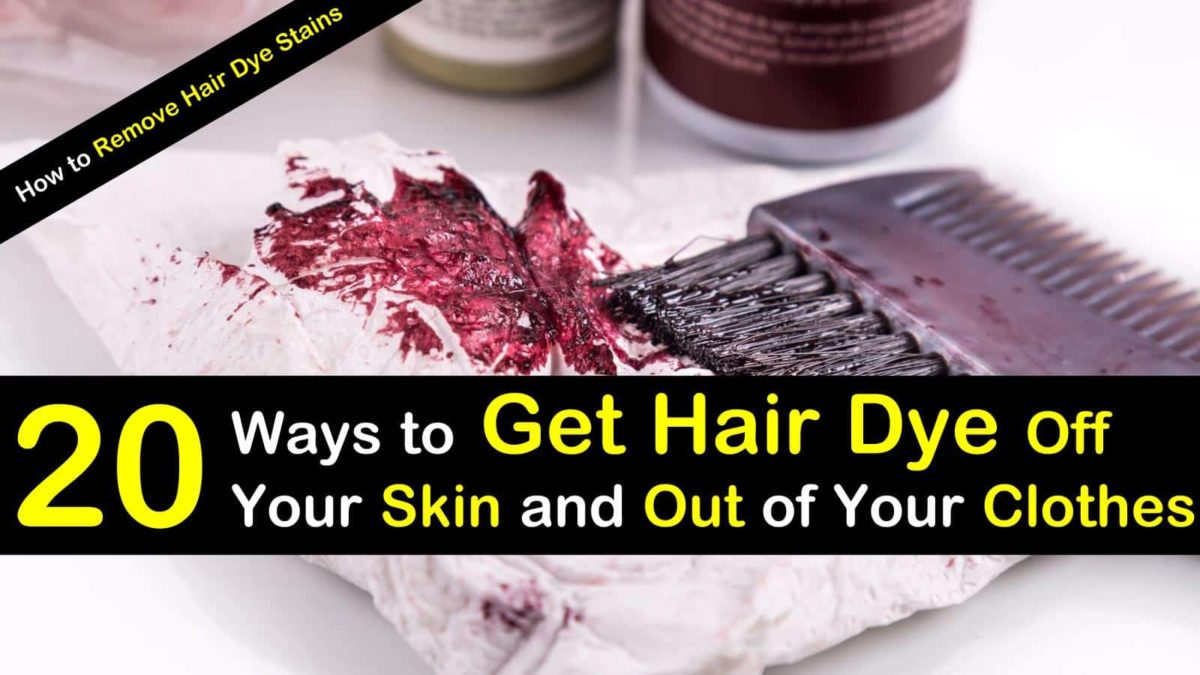Ever dyed your hair at home and ended up with vibrant streaks of color on your favorite shirt? Or perhaps you’ve been the victim of a rogue hair dye bottle, leaving behind a colorful catastrophe on your clothes. We’ve all been there, staring at a garment marred by hair dye, wondering if it’s beyond saving. But fear not, dear reader! This comprehensive guide will equip you with the knowledge and techniques to remove hair dye from clothes, bringing your favorite garments back to their former glory.

Image: www.tipsbulletin.com
Hair dye stains, often stubborn and seemingly permanent, can be a distressing experience. But with the right approach and a little elbow grease, you can conquer these colorful foes. This guide will delve into the science behind hair dye stains, explore a range of removal methods, and provide practical tips for each step. From simple laundry hacks to more advanced techniques, we’ll unravel the secrets to successfully removing hair dye from your clothes.
Understanding Hair Dye Stains
Hair dye, a complex concoction of chemicals, pigments, and developers, creates a vibrant transformation on our hair, but it can also leave behind indelible marks on fabrics. The pigments used in hair dye, often synthetic and highly concentrated, bind to the fibers of clothing, making them difficult to remove.
The type of dye and the fabric it stains play a crucial role in the effectiveness of removal methods. For example, permanent hair dyes tend to be more stubborn than semi-permanent or temporary dyes. Similarly, natural fibers like cotton and linen are more susceptible to staining than synthetic fabrics like polyester or nylon.
Pre-Treatment is Key
Before diving into the deep end of stain removal, it’s crucial to act quickly. The longer the hair dye sits on the fabric, the deeper it penetrates, making it harder to remove. Therefore, the first step is to pre-treat the stained area as soon as possible.
Begin by rinsing the stained fabric with cold water. Hot water can essentially set the dye, making it even more difficult to remove. Gently blot the excess water using a clean white towel or cloth. Avoid rubbing the stain as this can spread the color and damage the fabric.
Stain Removal Strategies: From Simple to Advanced

Image: drycleaningca.com
Simple Solutions
For fresh stains, some everyday household solutions can work wonders. Here are a few easy-to-use options:
- Dish Soap and Water: Mix a small amount of liquid dish soap with cold water, creating a soapy solution. Gently rub the solution onto the stain, avoiding harsh scrubbing that could damage the fabric. Allow the solution to sit for 5-10 minutes, then rinse thoroughly with cold water.
- Baking Soda: Make a paste using baking soda and a small amount of water. Apply the paste to the stain and let it dry completely, which may take several hours. Brush away the dried paste with a soft-bristled brush. This method works best for light-colored fabrics.
- Vinegar: White vinegar’s acidic properties can help break down hair dye molecules. Dilute white vinegar with water in a 1:1 ratio. Soak the stained area in the vinegar solution for about 30 minutes, then rinse thoroughly with cold water.
Advanced Techniques
If simple solutions aren’t enough to banish the stain, it’s time to escalate your stain-fighting arsenal. These advanced techniques require a bit more patience and attention but can effectively tackle stubborn hair dye stains.
- Hydrogen Peroxide: Hydrogen peroxide is a common bleaching agent, and it can be effective on light-colored fabrics. Prepare a 3% hydrogen peroxide solution (available at most drugstores) and apply it to the stain. Allow it to sit for 15-20 minutes, then rinse thoroughly with cold water.
- Color Remover: For deeper stains, a color remover product designed for fabrics can be a powerful tool. Follow the instructions on the product label carefully, as some color removers are specifically formulated for certain types of fabric.
- Commercial Stain Remover: Numerous stain removers specifically designed for hair dye are available on the market. These products often contain enzymes that break down the dye molecules, making them easier to remove. Be sure to read the instructions carefully and test the product on a hidden area of the garment before using it on the entire stain.
Washing the Stained Garment
After pre-treatment, it’s time to wash the garment. Use cold water, as hot water can set the dye deeper into the fabric. Avoid washing the garment with other clothes, especially if they are light-colored, to prevent the dye from transferring.
Choose a detergent specifically designed for removing tough stains. Check the label for “color safe” or “stain removal” properties. A gentle cycle is recommended to minimize potential damage to the fabric.
Preventing Hair Dye Stains
Preventing hair dye stains is a crucial step to keep your wardrobe safe and sound. Here are some preventative measures:
- Protect Your Clothes: Wear old, disposable clothing or a protective cape during the dyeing process.
- Use a Barrier: Apply Vaseline or a similar barrier cream to the neckline, ears, and forehead to minimize the risk of stains.
- Wash Hands: Wash your hands thoroughly with soap and water after applying hair dye.
- Clean Up Quick: Treat any spills or stains immediately with a stain remover or a simple cold water rinse.
How To Get Hair Color Out Of Clothes
Final Thoughts: A Colorful Success Story
Removing hair dye stains from clothes can seem challenging, but with patience, the right tools, and the tips outlined in this article, you can bid farewell to those colorful calamities. Remember, the sooner you treat the stain, the better. Approach each stain with a strategy, starting with simple solutions and progressing to advanced techniques if needed. As you gain experience, you’ll become a master of stain removal, transforming your colorful mishaps into a triumphant tale of restoration.

:max_bytes(150000):strip_icc()/OrangeGloEverydayHardwoodFloorCleaner22oz-5a95a4dd04d1cf0037cbd59c.jpeg?w=740&resize=740,414&ssl=1)




